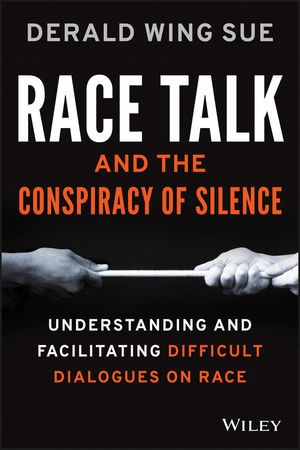Race Talk and the Conspiracy of Silence: Understanding and Facilitating Difficult Dialogues on Race
Wiley
January 2015
304 pages
Hardcover ISBN: 978-1-118-95872-8
Paperback ISBN: 978-1-119-24198-0
E-book ISBN: 978-1-118-95965-7
Derald Wing Sue, Professor of Psychology and Education
Columbia University, New York, New York
Turn Uncomfortable Conversations into Meaningful Dialogue
If you believe that talking about race is impolite, or that “colorblindness” is the preferred approach, you must read this book. Race Talk and the Conspiracy of Silence debunks the most pervasive myths using evidence, easy-to-understand examples, and practical tools.
This significant work answers all your questions about discussing race by covering:
- Characteristics of typical, unproductive conversations on race
- Tacit and explicit social rules related to talking about racial issues
- Race-specific difficulties and misconceptions regarding race talk
- Concrete advice for educators and parents on approaching race in a new way
Table of Contents
- Preface
- Preface to the Paperback Edition
- Acknowledgments
- About the Author
- SECTION ONE: THE CHARACTERISTICS, DYNAMICS, AND MEANING OF RACE TALK
- CHAPTER ONE What Is Race Talk?
- Race Talk Represents a Potential Clash of Racial Realities
- Race Talk Pushes Emotional Hot Buttons
- Race Talk Evokes Avoidance Strategies
- Why Is Successful Race Talk Important?
- CHAPTER TWO The Characteristics and Dynamics of Race Talk
- What Are Characteristics of Race Talk?
- How Do Societal Ground Rules (Norms) Impede Race Talk?
- Why Is Race Talk So Difficult and Uncomfortable for Participants?
- Conclusions
- CHAPTER THREE The Stories We Tell: White Talk Versus Back Talk
- Race Talk: Narratives and Counter-Narratives
- Telling on Racism: Unmasking Ugly Secrets
- CHAPTER ONE What Is Race Talk?
- SECTION TWO: THE CONSTRAINING GROUND RULES FOR RACE TALK
- CHAPTER FOUR “The Entire World’s a Stage!”
- The Politeness Protocol and Race Talk
- The Academic Protocol and Race Talk
- CHAPTER FIVE Color-Blind Means Color-Mute
- Color-Evasion: “We Are All the Same Under the Skin”
- Stereotype-Evasion: “I Don’t Believe in Those Stereotypes”
- Power-Evasion: “Everyone Can Make It in Society, If They Work Hard Enough”
- Myth of the Melting Pot
- CHAPTER FOUR “The Entire World’s a Stage!”
- SECTION THREE: WHY IS IT DIFFICULT FOR PEOPLE OF COLOR TO HONESTLY TALK ABOUT RACE?
- CHAPTER SIX “What Are the Consequences for Saying What I Mean?”
- Ethnocentric Monoculturalism
- Power and Oppression
- CHAPTER SEVEN “To Speak or How to Speak, That Is the Question”
- Communication Styles
- Nonverbal Communication
- Nonverbal Communication in Race Talk: Sociopolitical Considerations
- Being Constrained and Silenced: Impact on People of Color
- Conclusions
- CHAPTER SIX “What Are the Consequences for Saying What I Mean?”
- SECTION FOUR: WHY IS IT DIFFICULT FOR WHITE PEOPLE TO HONESTLY TALK ABOUT RACE?
- CHAPTER EIGHT “I’m Not Racist!”
- Cognitive Avoidance—Racism Denial
- Emotional Avoidance—Fear, Guilt, and Other Feelings
- Behavioral Avoidance—Helplessness and Hopelessness
- Emotional Roadblocks to Race Talk
- CHAPTER NINE “I’m Not White; I’m Italian!”
- What Does It Mean to Be White?
- The Invisibility of Whiteness: What Does It Mean?
- The Fear of Owning White Privilege
- Fear of Taking Personal Responsibility to End Racism: Moving From Being Nonracist to Becoming Antiracist
- CHAPTER EIGHT “I’m Not Racist!”
- SECTION FIVE: RACE TALK AND SPECIAL GROUP CONSIDERATIONS
- CHAPTER TEN Interracial/Interethnic Race Talk: Difficult Dialogues Between Groups of Color
- Interracial/Interethnic Relationship Issues
- Race Talk: Fears of Divide and Conquer
- Sources of Conflict Between People of Color
- CHAPTER ELEVEN Race Talk and White Racial Identity Development: For Whites Only
- Developing a Nonracist and Antiracist Racial Identity
- White Racial Identity Development and Race Talk
- CHAPTER TEN Interracial/Interethnic Race Talk: Difficult Dialogues Between Groups of Color
- SECTION SIX: GUIDELINES, CONDITIONS, AND SOLUTIONS FOR HAVING HONEST RACIAL DIALOGUES
- CHAPTER TWELVE Being an Agent of Change: Guidelines for Educators, Parents, and Trainers
- Talking to Children About Race and Racism
- Guidelines for Taking Personal Responsibility for Change
- CHAPTER THIRTEEN Helping People Talk About Race: Facilitation Skills for Educators and Trainers
- Ineffective Strategies: Five Things Not to Do
- Successful Strategies: Eleven Potentially Positive Actions
- CHAPTER TWELVE Being an Agent of Change: Guidelines for Educators, Parents, and Trainers
- References
- Author Index
- Subject Index
